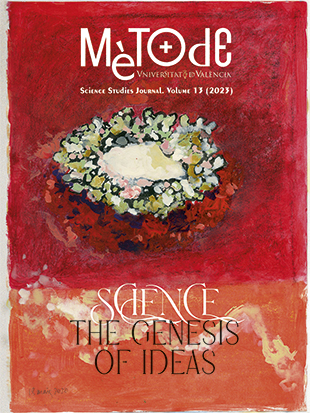Is beauty a criterion of truth? Genetic quality or aesthetic criteria, drivers of sexual selection in animals
DOI:
https://doi.org/10.7203/metode.13.24722Keywords:
sexual selection, beauty, evolutionary biology, evolution Abstract
Abstract
Do bees or hummingbirds perceive the beauty of the flowers they approach to take nectar? That is, can non-human animals appreciate beauty? Is there a universal truth regarding beauty? Or is it just a useful attribute, an indicator of a valuable trait? As with so many other natural phenomena, there is no simple answer to these questions. In the following document, we analyse different aspects of sexual selection and its connection (or lack thereof) to aesthetic criteria and the so-called handicap principle.
 Downloads
Downloads
 References
References
Brown, S. (2022). Naturalizing aesthetics. In A. Chatterjee & E. R. Cardillo (2022), Brain, beauty, & art: Essays bringing neuroaesthetics into focus (pp. 18–21). Oxford University Press. https://doi.org/10.1093/oso/9780197513620.003.0004
Buskes, C. (2006). Evolutionair denken: De invloed van Darwin op ons wereldbeeld. Uitgeverij Nieuwezijds.
Chatterjee, A., & Cardillo, E. R. (2022). Prologue: Where have we been, and where are we now? In A. Chatterjee & E. R. Cardillo, Brain, beauty, & art: Essays bringing neuroaesthetics into focus (pp. XI–XII). Oxford University Press.
Darwin, C. (1860, 3 April). Letter to Asa Gray. Darwin Correspondence Project. https://www.darwinproject.ac.uk/letter/DCP-LETT-2743.xml
Darwin, C. (1877). The descent of man, and selection in relation to sex. John Murray.
DeAngelis, R. S., & Hofmann, H. A. (2020). Neural and molecular mechanisms underlying female mate choice decisions in vertebrates. Journal of Experimental Biology, 223(17), jeb207324. https://doi.org/10.1242/jeb.207324
Deutsch, D. (2011). The beginning of infinity. Explanations that transform the world. Viking.
Hoke, K. L., Burmeister, S. S., Fernald, R. D., Rand, A. S., Ryan, M. J., & Wilczynski, W. (2004). Functional mapping of the auditory midbrain during mate call reception. Journal of Neuroscience, 24(50), 11264–11272. https://doi.org/10.1523/JNEUROSCI.2079-04.2004
Kandel, E. R. (2016). Reductionism in art and brain science. Bridging the two cultures. Columbia University Press.
Keagy, J., Savard, J.-F., & Borgia, G. (2009). Male satin bowerbird problem-solving ability predicts mating success. Animal Behaviour, 78(4), 809–817. https://doi.org/10.1016/j.anbehav.2009.07.011
Keagy, J., Savard, J.-F., & Borgia, G. (2011). Complex relationship between multiple measures of cognitive ability and male mating success in satin bowerbirds, Ptilonorhynchus violaceus. Animal Behaviour, 81, 1063–1070. https://doi.org/10.1016/j.anbehav.2011.02.018
Li, Q., Gao, K.-Q., Vinther, J., Shawkey, M. D., Clarke, J. A., D’Alba, L., Meng, Q., Briggs, D. E., & Prum, R. O. (2010). Plumage color patterns of an extinct dinosaur. Science, 327(5971), 1369–1372. https://doi.org/10.1126/science.1186290
Moreno, J. (2013). Evolución por selección sexual según Darwin. La vigencia de una idea. Síntesis.
Nadal, M., & Cela-Conde, C. J. (2022). Bringing it all together. Neurological and neuroimaging evidence of the neural underpinnings of visual aesthetics. In A. Chatterjee & E. R. Cardillo, Brain, beauty, & art: Essays bringing neuroaesthetics into focus (pp. 8–11). Oxford University Press. https://doi.org/10.1093/oso/9780197513620.003.0002
Nagel, T. (1974). What is it like to be a bat? The Philosophical Review, 83(4), 435–450. https://doi.org/10.2307/2183914
Osuna, A. J. (2017, 17 September). Antropomorfismo [conference session]. Naukas, Bilbao. https://www.eitb.eus/es/divulgacion/naukas-bilbao/videos/detalle/5082718/video-naukas-bilbao-2017-antonio-j-osuna-biotay-antropomorfismo/
Prokop, Z. M., Michalczyk, L., Drobniak, S. M., Herdegen, M., & Radwan, J. (2012). Meta-analysis suggests choosy females get sexy sons more than «good genes». Evolution, 66(9), 2665–2673. https://doi.org/10.1111/j.1558-5646.2012.01654.x
Prum, R. O. (2012). Aesthetic evolution by mate choice: Darwin’s really dangerous idea. Philosophical Transactions of the Royal Society B, 367(1600), 2253–2265. https://doi.org/10.1098/rstb.2011.0285
Prum, R. O. (2017). The evolution of beauty: How Darwin’s forgotten theory of mate choice shapes the animal world – and us. Anchor.
Rosenthal, G. G., & Ryan, M. J. (2022). Sexual selection and the ascent of women: Mate choice research since Darwin. Science, 375(6578), eabi6308. https://doi.org/10.1126/science.abi6308
Ryan, M. J. (2018). A taste for the beautiful. Princeton University Press.
Sainani, K. (2015). Q&A: David Deutsch. Nature, 526, S16. https://doi.org/10.1038/526S16a
Zahavi, A. (1975). Mate selection – a selection for a handicap. Journal of Theoretical Biology, 53, 205–214. https://doi.org/10.1016/0022-5193(75)90111-3
Downloads
Published
How to Cite
-
Abstract1159
-
PDF774
Issue
Section
License
![]()
All the documents in the OJS platform are open access and property of their respective authors.
Authors publishing in the journal agree to the following terms:
- Authors keep the rights and guarantee Metode Science Studies Journal the right to be the first publication of the document, licensed under a Creative Commons Attribution-NonCommercial-NoDerivatives 4.0 International License that allows others to share the work with an acknowledgement of authorship and publication in the journal.
- Authors are allowed and encouraged to spread their work through electronic means using personal or institutional websites (institutional open archives, personal websites or professional and academic networks profiles) once the text has been published.





